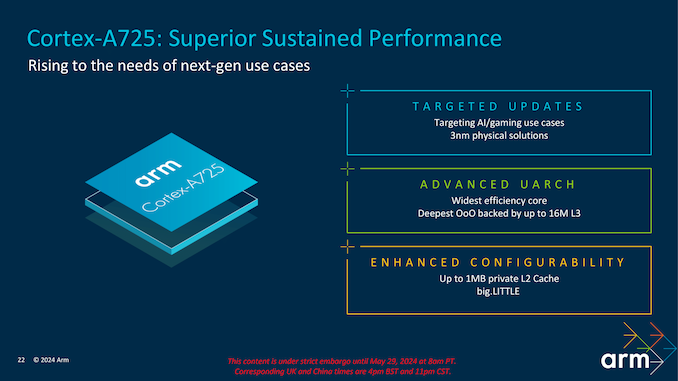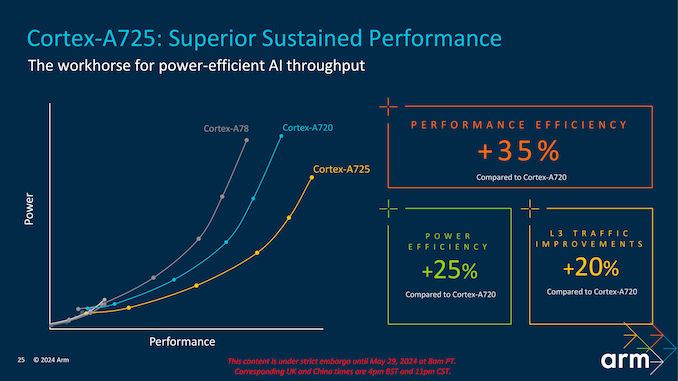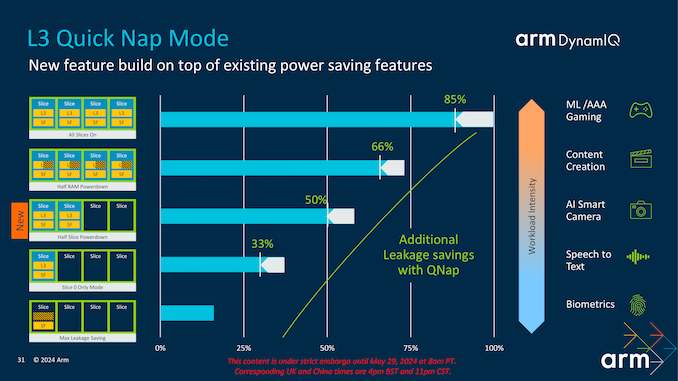Arm Unveils 2024 CPU Core Designs, Cortex X925, A725 and A520: Arm v9.2 Redefined For 3nm
by Gavin Bonshor on May 29, 2024 11:00 AM EST- Posted in
- CPUs
- Arm
- Smartphones
- Mobile
- SoCs
- Cortex
- 3nm
- Armv9.2
- Cortex-A520
- Cortex X925
- Cortex A725
Arm Cortex A725: Improvements to Middle Core Efficiency
The Arm Cortex-A725 is designed to balance performance and power efficiency, making it a critical component of the second-generation Armv9.2 architecture. Positioned as a mid-tier core, it complements the high-performance Cortex-X925 by offering robust capabilities for everyday computing tasks while maintaining energy efficiency. This core is especially targeted at devices that require consistent performance without the high power consumption associated with top-tier cores, such as smartphones, tablets, and laptops.
The Cortex-A725 builds on the successes of its predecessor, the Cortex-A720, with several key architectural enhancements. One of the significant improvements is the increased instruction issue queue and the expanded reorder buffer, which enable the core to handle more instructions simultaneously and execute them out of order for improved efficiency. This increase in the out-of-order execution window size allows the Cortex-A725 to utilize its execution units better, leading to smoother and faster processing of complex workloads.
The core also benefits from a new 1MB L2 cache configuration, which provides faster access to frequently used data and instructions. This larger cache size is designed to reduce latency and improve performance, particularly for applications that require rapid data retrieval. Additionally, the Cortex-A725 features enhancements in its register file structure, further streamlining data processing and reducing bottlenecks.
Power efficiency is a crucial aspect of the Cortex-A725's design. With leading-edge 2024 Cortex chips expected to be fabbed on newly-available 3nm process technologies from TSMC and others, the improved performance from these nodes is able to drive big improvements in energy efficiency, and Arm is leaning into that heavily with the A725. Overall, Arm is touting that A725 delivers significant power savings compared to previous generations. Compared to the Cortex-A720, the Cortex-A725 offers up to a 25% improvement in power efficiency (and 20% L3 traffic reduction), making it an ideal choice for mobile devices that require long battery life.
The core also features advanced power management capabilities, including dynamic voltage and frequency scaling (DVFS) and half-slice power-down modes. These features allow the Cortex-A725 to adjust its power consumption based on the current workload, ensuring energy is used efficiently without sacrificing performance.













55 Comments
View All Comments
StormyParis - Wednesday, May 29, 2024 - link
Do these processors have anything to prevent exploits such as RowHammer etc ... ? Those & variants have been a big story, then disappeared, but we were never told about an actual solution ? ReplyGeoffreyA - Wednesday, May 29, 2024 - link
Are these companies so lame with their AI desperation? Replyabufrejoval - Wednesday, May 29, 2024 - link
Memory tagging extensions have been around since ARM 8.5. When you say ARM 9.2 MTE, does that mean they have been significantly upgraded e.g. in the direction of what CHERI does for RISC-V?I've been trying to find out if ARM has an "AVX-512" issue with their different big/middle/small designs, too. That is if these distinct cores might actually differ in the range of instruction set extensions they support. And I can't get a clear picture, either.
So if say the big cores support some clever new vector formats for AI and the middle or small cores won't, how will apps and OS deal with the issue? Reply
GeoffreyA - Wednesday, May 29, 2024 - link
I don't know enough about ARM to comment, but should think that there are compatibility issues, with instructions, spanning different models and generations. Perhaps there's a feature-level type of method? ReplyFindecanor - Wednesday, May 29, 2024 - link
ARM MTE is much cruder than CHERI. It can be described as "memory colouring": Every allocation in memory is tagged with one of 16 colours. Two adjacent allocations can't have the same colour. When you use a pointer the colour bits in otherwise unused top bits of the pointer have to match the colour of the allocation it points into.With SVE both E and P cores need to have the same vector length, yes. The vector length is usually no larger than a cache line which have to be the same size anyway.
I don't know specifically about SME but many extensions have to first be enabled by the OS on a core to be available to user-mode programs. If not all cores have an extension, the OS may choose to not enable it on any. Reply
mode_13h - Thursday, May 30, 2024 - link
> The vector length is usually no larger than a cache line which have to be the same size anyway.Cache lines are usually 64 bytes, which is 512 bits. Presumably, the A520 has only SVE2 @ 128 bits. So, don't let ARM off the hook *that* easily! Reply
eastcoast_pete - Wednesday, May 29, 2024 - link
That is very much something I am wondering, too. Reports/rumors have it that, for example, Qualcomm chose not to enable SVE in the big cores of their SD 8 Gen3. Qualcomm isn't exactly forthcoming with information about that, not that I would expect them to comment. Replyname99 - Wednesday, May 29, 2024 - link
That's a silly response. It's like being present at the birth of Mac or Windows and saying "why are these stupid hardware companies trying so hard to make their chips run graphics fast?"The hope of LLMs is that they will provide a substantial augmentation to existing UI. So instead of having to understand a complicated set of Photoshop commands, you'll be able to say something like "Highlight the subject of the photo. Now move it about an inch left. Now remove that power line in the background".
This is not a trivial task; it requires substantial replumbing on existing apps, along with a fair degree of rethinking app architecture. Well, no-one said it would be easy to convert Visicalc to Excel...
But that is where things are headed. And because ARM (and Apple, and QC, and MS) are not controlled by idiots who think only in terms of tweets and snark, each of these companies is moving heaven and earth to ensure that they will not be irrelevant during this shift.
(Oh, you thought the entire world consisted of LLMs answering questions did you? Strange how the QUESTION-ANSWERING COMPANY, ie Google, has created that impression...
Try thinking independently for once. Everything in the world happens along a dozen dimensions at once. All it takes to be a genius is to be able to hold *more than one* dimension in your head simultaneously.) Reply
FunBunny2 - Wednesday, May 29, 2024 - link
Well, no-one said it would be easy to convert Visicalc to Excel..well... Mitch did it, in assembler at first, and called it Lotus 1-2-3 Reply
GeoffreyA - Thursday, May 30, 2024 - link
You can go on with your ad hominen and air of superiority; it won't change that these companies are tripping over themselves, in insecurity and desperation, to grab dollars from the AI pot or not be left behind.You make assumptions about my ideas based on one sentence. In fact, AI is quite interesting to me. Not how it's going to help someone in Photoshop or Visual Studio, but where LLMs eventually lead; whether they end up being the language faculty in strong AI, or more; what's missing from today's LLMs (state, being trained in real-time, connecting to the sense modalities, using little power in a small space, etc.); and whether consciousness, the last great riddle, will ever be solved, how, and the moral implications. That's of interest to me.
But when one see Microsoft and Intel making an "AI PC," or AMD calling their CPU "Ryzen AI," and so on, it is little about true AI and more about money, checklists, and the bandwagon. Independence of thought is about seeing past fashion and the in-thing. And no thank you: I have got no desire, nor the insecurity, to want to be a genius. Reply